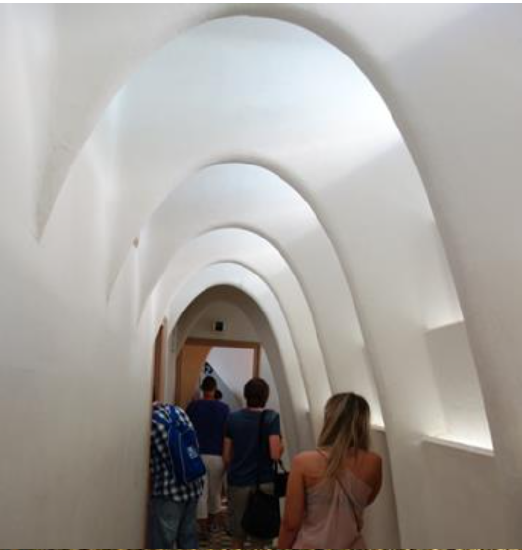1.4: Ideal Arches
( \newcommand{\kernel}{\mathrm{null}\,}\)
Now let’s consider some upside-down curves, arches. Start with a Roman arch, an upside-down U.

Typically, Roman arches are found in sets like this, but let’s consider one free standing arch. Assume it’s made of blocks having the same cross-section throughout. What is the force between neighboring blocks? We’ll do an upside-down version of the chain force analysis we just did.
Equating the pressure forces on the arch segment colored dark in the figure, we see pressure on the lowest block in the segment must have a horizontal component, to balance the forced at the top point, so the cement between blocks is under shear stress, or, for no cement, there’s a strong sideways static frictional force. (So a series of arches, as shown in the photograph above, support each other with horizontal pressure.)

A single Roman arch like this is therefore not an ideal design—it could fall apart sideways.
Let’s define an ideal arch as one that doesn’t have a tendency to fall apart sideways, outward or inward. This means no shear (sideways) stress between blocks, and that means the pressure force between blocks in contact is a normal force—it acts along the line of the arch. That should sound familiar! For a hanging string, obviously the tension acts along the line of the string.
Adding to our ideal arch definition that the blocks have the same mass per unit length along the entire arch, you can perhaps see that the static force balance for the arch is identical to that for the uniform hanging string, except that everything’s reversed—the tension is now pressure, the whole thing is upside down.
Nevertheless, apart from the signs, the equations are mathematically identical, and the ideal arch shape is a catenary. Of course, some actual constructed arches, like the famous one in St. Louis, do not have uniform mass per unit length (It’s thicker at the bottom) so the curve deviates somewhat from the ideal arch catenary.

Here’s a picture of catenary arches—these arches are in Barcelona, in a house designed by the architect Gaudi.

In fact, Gaudi designed a church in Barcelona using a web of strings and weights to find correct shapes for the arches—he placed a large horizontal mirror above the strings, so looking in the mirror he could see what the actual right-way-up building would look like!—The lower image shows how he did it. (This model is in the church.)


